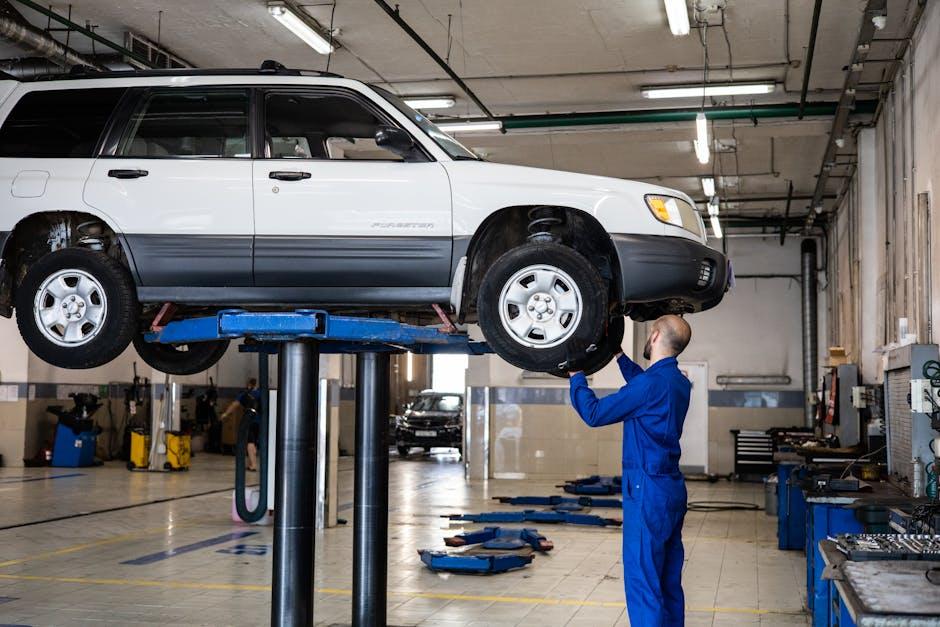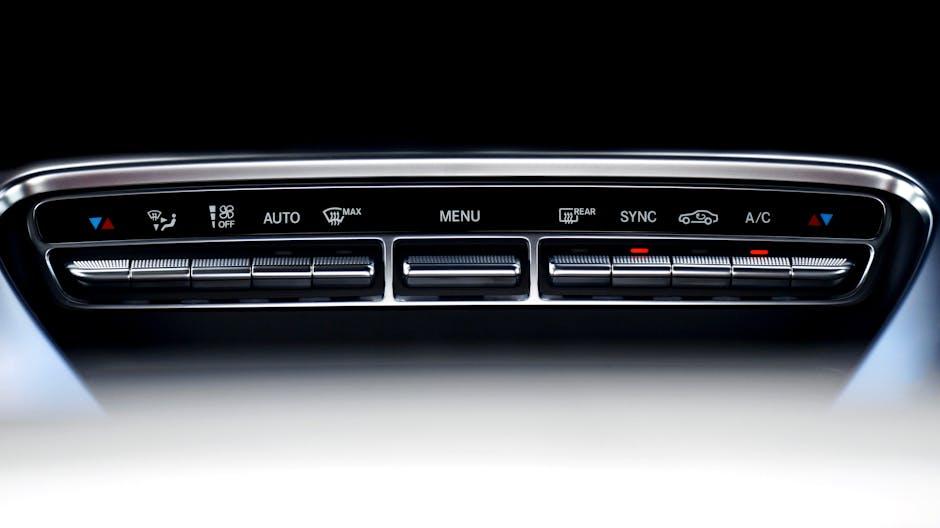When summer’s heat starts to climb and the sun blazes down on the asphalt, your car’s air conditioning becomes more than just a luxury—it’s a necessity. But like any complex system, your vehicle’s AC needs a little care to keep it humming smoothly and efficiently. Whether you’re gearing up for a long road trip or simply want to enjoy a cool ride during the daily commute, understanding how to maintain your car’s air conditioning can save you discomfort—and potentially costly repairs. In this article, we’ll explore practical tips and essential steps to ensure your car’s AC stays in top shape, delivering refreshing breezes whenever you need them most.
Table of Contents
- Understanding Your Car AC System for Optimal Performance
- Regular Inspection and Maintenance Tips to Extend AC Life
- Choosing the Right Refrigerant and How to Refill It Properly
- The Importance of Cabin Air Filters and How to Replace Them
- Signs of AC Trouble and When to Seek Professional Help
- Energy-Saving Practices to Keep Your AC Efficient on Hot Days
- Q&A
- Wrapping Up

Understanding Your Car AC System for Optimal Performance
To maintain your vehicle’s air conditioning at peak efficiency, it’s essential to grasp how its core components collaborate. The AC system relies on a few key parts working harmoniously: the compressor compresses and circulates refrigerant, the condenser dissipates heat, the evaporator absorbs heat from inside the car, and expansion valves regulate refrigerant flow. Regularly checking each part prevents minor hiccups from evolving into costly repairs. Remember, a well-lubricated compressor and clean condenser fins are the unsung heroes that keep your cabin cool, especially during long summer drives.
Routine maintenance is more than just topping off refrigerant—it includes inspecting belts, seals, and electrical connections. Keeping the cabin air filter clean also significantly boosts airflow and reduces strain on your system. Consider these tips for optimized care:
- Check refrigerant levels: Low refrigerant can cause the compressor to overheat and fail.
- Inspect condenser and evaporator: Ensure there’s no debris or damage hampering heat exchange.
- Replace cabin air filters: Clean air filters enhance air quality and system efficiency.
- Monitor electrical components: Faulty wiring or switches could disrupt AC operation.
| Component | Signs of Trouble | Maintenance Tip |
|---|---|---|
| Compressor | Humming noise or no cooling | Regular lubrication and refrigerant check |
| Condenser | Overheating or blocked fins | Clean debris and inspect for leaks |
| Evaporator | Weak airflow or odors | Flush evaporator and replace filters |
| Expansion valve | Fluctuating temperature | Professional servicing recommended |

Regular Inspection and Maintenance Tips to Extend AC Life
Keeping your car’s AC system in top shape requires more than just turning it on during hot days. Regularly checking key components helps prevent costly repairs and ensures the unit performs smoothly. Start by inspecting the air filter every few months, as a clogged filter restricts airflow and reduces cooling efficiency. Additionally, examine the AC compressor belt for any signs of wear or cracks, replacing it if necessary to avoid sudden failures. Don’t overlook the refrigerant levels—low refrigerant can cause the system to struggle, while overfilling may lead to leaks and damage.
Maintenance also includes routine cleaning and servicing to enhance longevity. Make it a habit to keep the condensate drain clear, preventing water buildup that can lead to mold and unpleasant odors. Below is a quick reference table to guide your inspection schedule:
| Component | Inspection Frequency | Maintenance Tip |
|---|---|---|
| Air Filter | Every 3 months | Replace or clean regularly |
| Compressor Belt | Every 6 months | Check for cracks or fraying |
| Refrigerant Levels | Every 12 months | Recharge or repair leaks |
| Condensate Drain | Every 6 months | Clear blockages promptly |
- Run the AC regularly even in cooler months to keep seals lubricated.
- Verify cabin air filters are clean to improve air quality inside the car.
- Schedule professional check-ups annually for comprehensive diagnostics.

Choosing the Right Refrigerant and How to Refill It Properly
When it comes to selecting the ideal refrigerant for your car’s AC system, understanding its compatibility and environmental impact is key. Most modern vehicles use R-134a or the newer, eco-friendlier R-1234yf. Choosing the wrong type can not only harm your system but also lead to higher emissions. Always check your owner’s manual or consult a professional to ensure you’re using the right refrigerant tailored to your car’s make and model.
Refilling your AC isn’t just about topping off the refrigerant; it requires precision and care to avoid damage. The process should ideally be done using a vacuum pump to remove moisture and air from the system before adding the refrigerant. Here are the essential steps to follow:
- Identify the correct fill port: Usually marked as low-pressure and high-pressure.
- Use a gauge set: To monitor system pressure while refilling.
- Fill slowly: Add refrigerant in small increments to avoid overcharging.
- Check for leaks: Use a leak detector or soapy water around fittings.
- Test the system: Ensure proper cooling and listen for unusual sounds post-refill.
| Refrigerant Type | Environmental Impact | Compatible Vehicles |
|---|---|---|
| R-134a | Moderate GWP* | Most pre-2015 models |
| R-1234yf | Low GWP* | Many post-2015 models |
*GWP = Global Warming Potential

The Importance of Cabin Air Filters and How to Replace Them
Cabin air filters play a crucial role in maintaining the quality of the air inside your vehicle. These filters trap dust, pollen, pollutants, and even unpleasant odors, ensuring that the air flowing through your car’s HVAC system is clean and fresh. Ignoring the condition of your cabin air filter can lead to reduced airflow, making your AC work harder and less efficiently. Over time, a clogged filter can compromise not only your comfort but also the health of passengers, especially those with allergies or respiratory issues.
Replacing the cabin air filter is a straightforward task that can be done with minimal tools and effort, usually located behind the glove compartment or under the dashboard. For best results, check your vehicle’s manual for manufacturer recommendations, but a good rule of thumb is to replace the filter every 12,000 to 15,000 miles. Below is a quick reference table to help determine when you might need a replacement based on common driving environments:
| Driving Environment | Suggested Replacement Interval |
|---|---|
| Urban Areas | Every 12,000 miles |
| Rural or Clean Areas | Every 15,000 miles |
| Dusty or Off-Road Conditions | Every 6,000 – 10,000 miles |
When replacing the filter, ensure you have the correct one for your make and model, and handle it carefully to avoid releasing trapped debris back into the air vents. By maintaining a fresh cabin air filter, you not only improve your vehicle’s AC efficiency but also contribute to a healthier, more pleasant driving environment.

Signs of AC Trouble and When to Seek Professional Help
If you notice your car’s AC isn’t cooling as effectively as before, it’s a sign that maintenance may be overdue. Unusual odors, strange noises like rattling or hissing, and inconsistent airflow can all signal potential issues. Sometimes the problem could be as simple as a clogged cabin air filter or low refrigerant levels, but other times, it may point to more complex mechanical faults. Keep an eye out for these symptoms to prevent further damage:
- Weak or warm air blowing from vents
- Unpleasant or moldy smells when AC runs
- Rapid increase in cabin temperature despite cooling
- AC compressor cycles on and off frequently
- Dazzling drops of moisture or refrigerant leaks under the car
Knowing when to call in a professional can save you time and money in the long run. If you experience any of the above signs, or notice a sudden decrease in AC performance after a tune-up, it’s best to consult an expert. Here’s a quick guide to help you decide your next steps:
| Symptom | Possible Cause | Recommended Action |
|---|---|---|
| Warm air despite AC on | Low refrigerant or faulty compressor | Visit technician for recharge or repair |
| Unusual smells | Mold buildup or dirty filter | Replace filter; professional cleaning |
| Intermittent cooling | Electrical faults or sensor issues | Diagnostics by certified mechanic |
| Odd noises | Loose or damaged components | Immediate professional inspection |

Energy-Saving Practices to Keep Your AC Efficient on Hot Days
Maintaining optimal AC efficiency on scorching days isn’t just about setting the temperature low; it’s about smart energy use. Start by parking in shaded areas whenever possible or use a windshield sunshade to reduce cabin heat buildup. This simple move drastically cuts down the workload for your AC system. When you start your ride, crack the windows for a few minutes to let hot air escape before switching on the AC. This prevents the system from overworking to cool down overheated interiors.
Adjusting your car’s settings cleverly helps sustain both comfort and efficiency. Use the recirculation mode wisely—it cools the internal air faster rather than constantly drawing in hot outside air, reducing energy consumption. Additionally, delay switching on the AC until the engine reaches optimal operating temperature; cold starts demand more energy. Consider this quick reference to see how minor adjustments impact your fuel and energy use:
| Practice | Estimated Energy Saving | Comfort Level |
|---|---|---|
| Parking in Shade | Up to 15% | High |
| Using Recirculation Mode | 10-12% | Medium |
| Pre-ventilating Cabin | 8-10% | High |
| Delaying AC Use Until Engine Warm | 5-7% | Medium |
Q&A
Q&A: How to Keep Your Car’s AC Running Efficiently
Q1: Why is it important to keep my car’s AC running efficiently?
A1: A well-maintained AC saves fuel, ensures comfortable drives, and prolongs the life of your vehicle’s cooling system. Efficient AC performance prevents breakdowns during hot spells and reduces costly repairs.
Q2: How often should I check my car’s AC system?
A2: Ideally, have your AC inspected at least once a year before summer, or every 12,000 to 15,000 miles. Regular checks help identify issues early, like leaks or low refrigerant levels.
Q3: Can I do any maintenance myself to improve AC efficiency?
A3: Yes! Keep the cabin air filter clean or replace it regularly to ensure optimal airflow. Also, park in shaded areas to reduce the cabin heat build-up, helping your AC cool faster and work less.
Q4: What signs indicate my AC might need servicing?
A4: Notice weak airflow, unusual noises, a strange smell when running the AC, or insufficient cooling? These symptoms often point to low refrigerant, clogged filters, or compressor problems that need professional attention.
Q5: Does running the AC differently affect its efficiency?
A5: Absolutely. Start by ventilating your car with windows down for a minute or two before switching on the AC, getting rid of hot air inside. Use the recirculate setting once the interior is cooler for faster and more efficient cooling.
Q6: How does refrigerant impact AC efficiency?
A6: Refrigerant is the lifeblood of your AC system. Low levels reduce cooling power, and leaks can lead to compressor damage. Regular refills and leak checks keep your AC humming efficiently.
Q7: When should I replace my AC components?
A7: Components like the cabin air filter, belts, or compressor clutch may wear out over time. Replace filters every 12,000 miles or as recommended, belts at the first sign of cracks, and seek professional evaluation if the compressor struggles.
Q8: Can using alternative cooling methods help preserve my car’s AC?
A8: Shade your car, use sunshades, and keep windows slightly cracked (if safe) to reduce internal heat buildup, easing the load on your AC. These simple habits extend the system’s life and improve efficiency.
Q9: Is professional servicing necessary even if my AC seems fine?
A9: Yes, routine professional servicing flushes out contaminants, checks refrigerant levels accurately, and ensures that all components function properly, preventing unexpected failures and maintaining peak efficiency.
Q10: How does climate and driving style affect AC performance?
A10: Hotter climates and heavy stop-and-go traffic place more strain on your AC. Gentle driving with smooth starts and stops, along with protecting your car from extreme heat, helps the system maintain optimal performance.
Keeping your car’s AC efficient is about combining smart habits with regular care. With a little attention, your car’s cooling system will keep you comfortably cool mile after mile!
Wrapping Up
Maintaining your car’s air conditioning system doesn’t have to be a complex chore. With a little regular care and attention, you can enjoy cool, refreshing drives no matter how scorching the summer sun gets. By staying proactive—checking refrigerant levels, replacing filters, and scheduling timely professional inspections—you ensure your AC not only performs efficiently but also lasts longer. Remember, a well-functioning AC is more than just a comfort feature; it’s a key to safer, more enjoyable journeys ahead. So, take the time today to give your car’s cooling system the care it deserves, and let every ride be a breath of fresh, chilled air.

